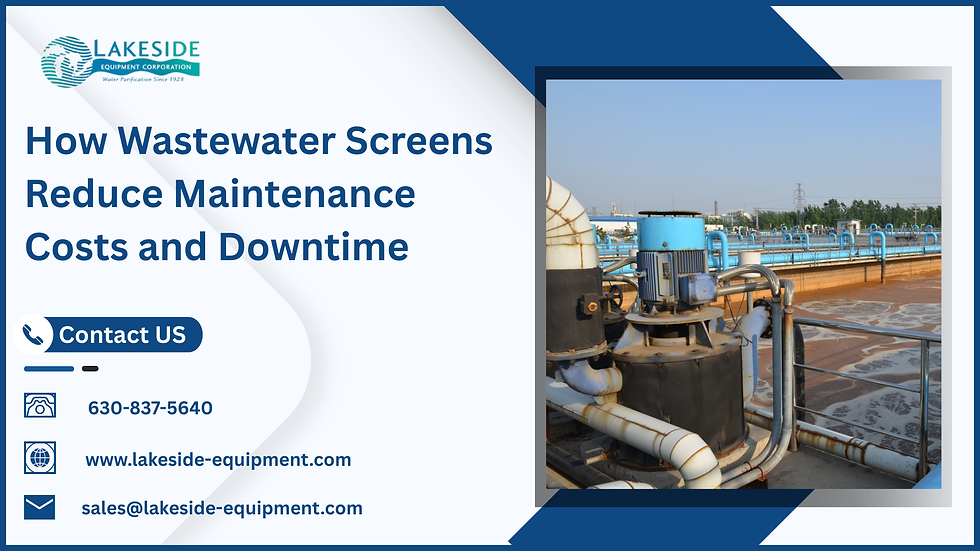Extending the Life of Your Sewage Grinder Pump System: Pro Tips & Tools
- lakesideequipment

- May 8
- 3 min read
Ever dealt with a failing sewage grinder pump system right when you needed it most? You're not alone. In industrial and municipal wastewater systems, downtime isn’t just inconvenient, it’s expensive. The good news? With the right upkeep and tools, your sewage grinder pump system can keep grinding for years beyond its expected lifespan.
In this post, we’re diving into field tested strategies and industry approved tools to help you protect your equipment investment. Whether you're running a municipal facility or managing an industrial site, these tips will help you get the most out of your industrial sewage pumps and screening systems like the Duperon FlexRake.

Why Preventive Care Beats Costly Repairs
Let’s get real: waiting for something to break before fixing it is a bad business model. Regular maintenance isn't just a box to check it’s the backbone of system longevity.
When it comes to your sewage grinder pump system, routine inspections, part replacements, and cleaning protocols can drastically reduce the chance of system failure. Pumps and grinders operate in high stress, debris heavy environments. A small issue left unchecked like ragging or grit accumulation can escalate into full system shutdowns.
Pro Tip 1: Know What You’re Working With
First things first, understand the specifications and limitations of your system. Is your pump rated for heavy solids? How often does it cycle? What type of screening system is upstream?
For example, if you’re using Duperon FlexRake as your screening solution, you already have a head start. This self-cleaning, front cleaning bar screen is designed to remove large solids before they hit the grinder, reducing wear and tear on downstream pumps. But even the most advanced technology can’t make up for poor maintenance.
Quick Checklist:
Review pump model specs and flow rates
Document baseline performance metrics
Monitor energy usage for signs of inefficiency
Pro Tip 2: Keep Solids Where They Belong
A grinder pump is only as good as what it doesn't have to grind. One of the most common causes of premature failure is overloading the system with non-grindable material rags, plastics, or worse.
Installing a reliable screening system like Duperon FlexRake can act as a protective shield. It captures and removes debris before it ever reaches your grinder or pump. This not only extends the life of your equipment but also improves overall system flow and reduces the chance of clogs.
Mini Case Study:
A Midwest food processing plant installed a Duperon FlexRake paired with an industrial grade grinder pump. After one year, they reported a 40% decrease in maintenance calls and a significant drop in unplanned shutdowns.
Pro Tip 3: Lubrication, Alignment, and Electrical Checks
Think of your sewage grinder pump like a car engine, it needs regular oiling, alignment, and attention to electrical integrity. Here’s what to focus on:
Maintenance Must Do’s:
Lubricate seals and bearings according to manufacturer guidelines
Inspect motor alignment and vibration levels
Test electrical panels for moisture intrusion or overload
Ignoring these details may seem harmless until you’re dealing with a burnt-out motor or a snapped impeller blade.
Pro Tip 4: Monitor for Ragging and Grit Build Up
If you’re not watching for ragging that is, accumulation of stringy waste like wipes and towels you’re inviting pump damage. Industrial sewage pumps, even the tough ones, aren’t invincible.
Use pressure and flow monitoring to detect early signs of obstruction. Many modern SCADA systems can provide alerts before damage occurs, giving you enough time to schedule proactive cleaning or part swaps.
Pro Tip 5: Train Your Operators (They’re Your First Line of Defense)
Even with the best equipment, untrained operators can unknowingly reduce system efficiency. Make sure your maintenance crew knows how to:
Read pump performance logs
Identify abnormal sounds or smells
Respond to warning alarms without delay
A trained operator can spot a struggling grinder long before it fails, saving you from costly downtime.
Must Have Tools for Grinder Pump Longevity
When it comes to maximizing equipment life, having the right tools in your kit can make all the difference.
Recommended Tools:
Vibration analysis sensors for early detection of mechanical issues
Thermal imaging to catch motor or wiring overheating
Debris bypass kits for emergency system clearing
Remote monitoring systems to keep an eye on your pumps 24/7
Closing Thoughts: Don’t Let Preventable Issues Cut Your System’s Life Short
Your sewage grinder pump system is a workhorse but even workhorses need care. By combining high performance screening like the Duperon FlexRake, regular maintenance, and smart monitoring, you can push your equipment years beyond its standard lifecycle.
Remember: a few hours spent on prevention today could save you weeks of costly downtime tomorrow.
Ready to Extend Your System’s Life?
If you're looking to optimize your industrial wastewater setup or need help selecting the right industrial sewage pumps and screening solutions, we're here to help.




Comments